This is Greenpoint’s beautiful St. Elias Church, located on shady Kent Street. And yes, that’s a FOR RENT sign on the front.
Once serving the community as both a church and Sunday school for more than 140 years, St. Elias is now completely empty, and has been since 2007, when the property was purchased by developers.
For a while, the plan was to sell it as a mansion, with an asking price of $3.4 million for the church and $3.7 million for the school portion (the facade would be preserved). Unfortunately, the days of eccentric buyers purchasing empty churches seems to have passed, and St. Elias’ future is somewhat up in the air.
The good news is that St. Elias is available for film shoots, and any number of other short term uses. In fact, it was rented for a robot orchestra in February!
From a scouting standpoint, St. Elias is a one-of-a-kind shooting location. Finding film-friendly churches can be difficult, because you often run into the question of content approval. And for some reason, a lot of movies shot in New York don’t always portray the church in the kindest light…
There’s a lot of great detail in the church portion, which is lined with mahogany pews:
The school is equally impressive, with a mezzanine and windows encompassing the third-story level:
I love this choir loft on the upper level…
…which has two enormous sliding frosted glass window panels. I wonder how many kids sang up here over the years:
A very curvy hallway…
A classroom, with hardwood floors:
I believe this was the former vestiary:
A small chalkboard – no chalk, but the string still hangs. Something about this makes me sad, not sure why.
Beautiful windows at the entrance:
Stained glass windows poking through the decay:
The trap door to the tower, which has views of Manhattan:
But my favorite hidden find in St. Elias? This wooden bar in the basement, which feels as old as the church:
Note the liquor racks on the walls…
I would love to know if everyone knew about it…or if only certain parishioners were privy to its existence! It was a Catholic church after all…
-SCOUT
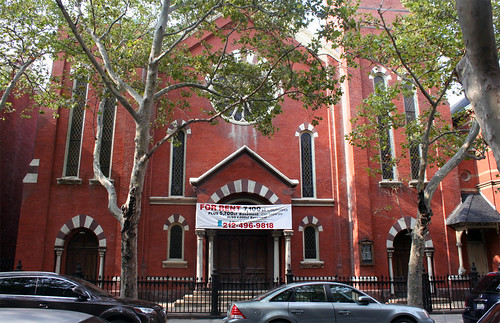
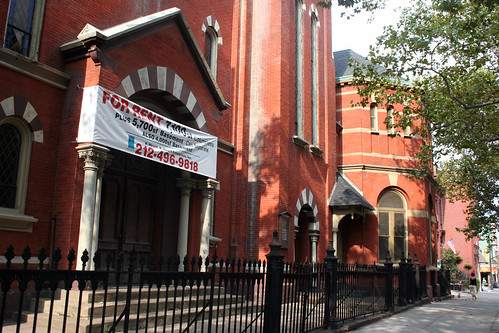
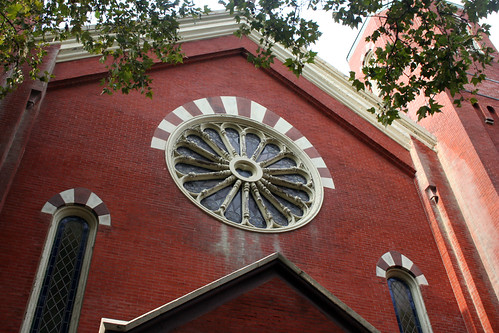
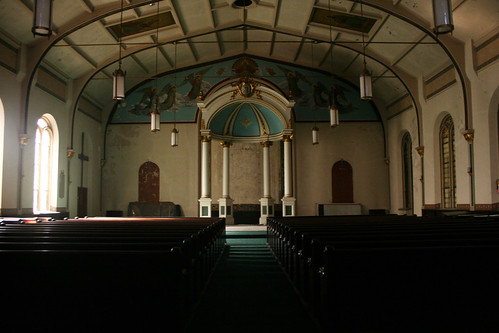

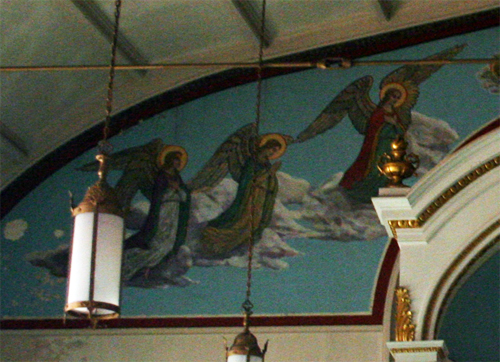


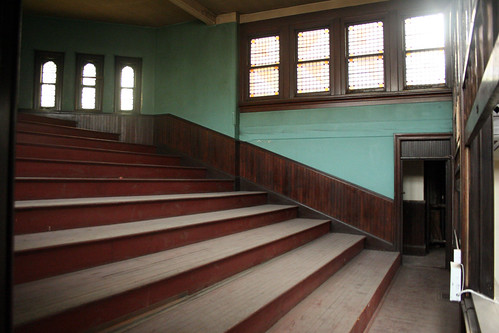


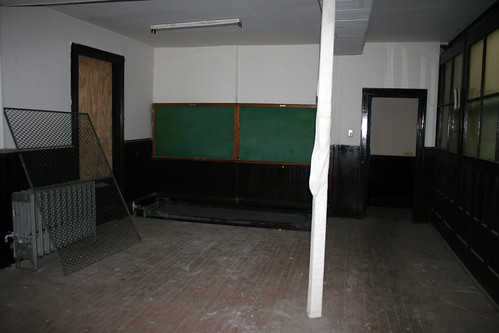




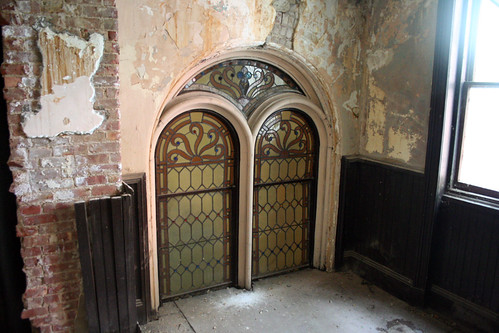
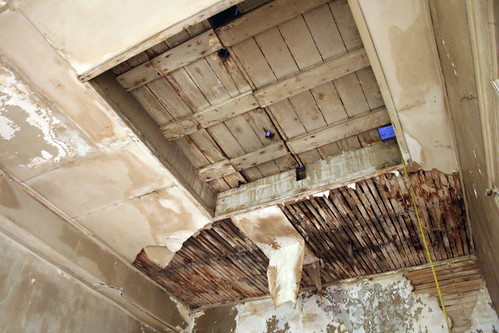
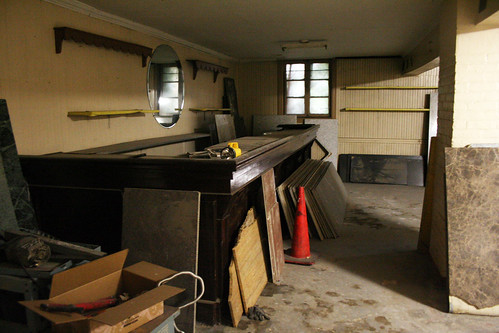


I passed by here Monday night and noticed the for rent sign, too. If only I had $4 million or so to spend…
This church looks perfect for so many different things. I’m surprised someone hasn’t thought of using it for weddings and hosting fancy receptions.
As for the liquor rack, it wouldn’t surprise me if that’s where the stored the communion wine. The church looks rather large, and at one time the number of parishoners might have called for a lot of wine being stocked. If I remember correctly (Catholic mother raised Protestant) communion is given every week. Can’t remember for sure.
This was not a traditional Roman Catholic Church. I know, because my friend Annmarie attend and was married in this church. I was in her wedding party. She often referred to this church as Greek Catholic. As for Communion wine, it is not stored at a bar in the basement. It is stored in the room off the altar and poured by the altar servers before the service or Mass.
There’s a Catholic church in Waterbury, Connecticut (St. Joseph’s) which for many years has had public bowling alleys in the basement.
OOh! Thanks for posting this! I walked by this the other day and noticed the ‘for rent’ sign and thought about how amazing it would be to live there.
Miles Davis lived in a converted church at, I believe, midtown, on the west side. This one might be good for another musician?
Actually, it was not a Catholic Church for most of its history; it was the Dutch Reformed Church from the time it was built, in 1870, to 1940, when its most notorious clergyman, the Rev. Benny Benson, who in 1937 had burned a Bible in the pulpit there (“If nobody is going to read this thing, you might as well burn it”), moved the congregation to their present home in the former Greenpoint YWCA on Milton Street, where they are still going strong. (It was after the move, in 1946, that Benson led a prayer meeting on the steps of Boro Hall for the Dodgers to win the pennant, though it didn’t do much good; dem Bums gave up two runs in the top of the ninth to lose the deciding game 11-9.)
i stumbled across your site when my friend found the shopping cart w/ cement shoes… these are gems. that’s really a good price for the lot/building!! (says a broke musician..) I’m donating a small chunk of change, but also, i am intrigued by your approach and would love to donate time/gear for the audio end of your film!
Speakeasy, perhaps?
An Irish woman I used to rent a room from was explaining to me how most of the Catholic churches in Ireland had small pubs attached for the congregation and community to gather and mingle. It served as a source of income for the church, as well as insurance that there would be quite a few people asking for forgiveness on Sunday. Apparently, the church she grew up in over there was somewhat tongue-in-cheek about it. The church itself was St. Joseph’s and the pub was known as Holy Joe’s.
I’m from Ireland, and that is not true. At all.
They don’t build churches like this anymore. They don’t build anything like this anymore. Makes me sad.
What a beautiful building, with so much character and personality.
Growing up Italian Roman Catholic, I can tell you we {they} drink and gamble, especially at feast times. They also may have rented out the basement for wedding receptions, baptism receptions, etc. I always thought it was an Italian thing, but I guess it’s everybody.
It occurred to me that if it looks to commercial that maybe the bar was for a chapter of the Knights of Columbus not the most common use but at least plausible.
I used to live next door to this beautiful building and always wondered about the interior… really happy you chose to profile it here. This part of Kent St. is so lovely. I’d love an inside look at the Renaissance-style columned house at 130 Kent, supposedly the home of Neziah Bliss.
i’m wondering if the “choir” space w/ roll up windows was not reserved for African American’s? is is in the back of the church? that might make sense if once all the congregation was seated, the windows would be rolled up so that people inside the loft could see w/o being seen. andy
Hi Andy. Good question. Not to my knowledge as the church was always an ethnic Slovakian parish for a century. If I recall the cornerstone correctly, the building was built in the mid-1800s and initially served as a Methodist or Lutheran church – but I could be wrong. Posters Annie or J. Lavryshyn below might know for sure. As to that choir space, it overlooks the parish social hall. If you view the 12th photo from the bottom, i.e., the view looking up at the choir loft, the sanctuary or church area itself is on the other side of those tall arched windows on the right.
You are right, Mike. There was a Slovakian group of parishioners attached to St. Elias. It was a very tight knit group for many years. My friend, who lived on Kent Street, attended this parish and her grandmother used to speak Slovak to my mother who spoke Polish and they understood each other. Memories!!
Note the earlier comment by DHM – this building was originally built by the Dutch Reformed Church, and served the congregation until the early 1940s when they moved from Kent St. to Milton St. At that time, the building had a complete steeple, which was in disrepair and which was later removed by the congregation which bought the building – St. Elias’, which was a Greek Rite Catholic congregation. This is a different Catholic than the Roman Catholic church.
A bar would be great for catered occasions like weddings.
I just read this entry for the first time yesterday, and now today there is a story in the New York Times about two immigrant congregations fighting over a Methodist church in Brooklyn. You’d think one or the other would adopt an abandoned church building like this one.
http://www.nytimes.com/2010/12/29/nyregion/29church.html?hp=&pagewanted=all
I grew up in Greenpoint. Kent St.was right around the cornor where I lived for 40 yesrs.That church was beautiful. I sometimes went to mass there even though I was raised Catholic. This church is only one of the many things I remember about Greenpoint.
“i’m wondering if the “choir” space w/ roll up windows was not reserved for African American’s? is is in the back of the church?”
Obviously not- see two pics above roll up window pic. Also, I’ve never one seen a pub attached to a church in Ireland.
My father restored the stained glass windows in this church about 15 years ago. His brother (my uncle) lived 3 doors down and we would often play wiffle ball on the street and get our balls stuff on the roof of the church. Who knows how many things are stuck up there now!
ST. ELIAS WAS MY PARISH. THE BUILDING HAS LOTS OF MEMORIES AND I AM GLAD IT IS STILL NOT TORN DOWN
Is this you, Annmarie?
Does anyone know where the records of the Greek Catholic Church might have gone? Did they relocate or just close shop?
Something that is not noted here is that St. Elias was never a “Roman Catholic” church but was (as noted just above), a Greek Catholic church.
As such, the church pertained to the Eparchy of Passaic, NJ (Byzantine-Ruthenian Catholic). It is most likely there, that any records would be kept. Greek Catholics are in communion with the pope and the Vatican, but celebrate the liturgy (mass) of the Greek Rite and have their own customs, laws and traditions.
The founders of St. Elias would have come from the Carpathian mountain region of present day Ukraine, Slovakia and Hungary. The language they spoke is known as “Rusyn”, a dialect of Ukrainian.
St. Elias is a very historically significant parish for Greek Catholics. A noteworthy priest, Fr. John Slivka, served as pastor for many years. He compiled the invaluable book entitled “Historical Mirror” which contains documents and information from the early days of the Ruthenian Greek Catholic Church in the USA. He also composed catechisms and published some of the first liturgical books in English.
Also, the infamous Archbishop Fulton J. Sheen celebrated the Byzantine Divine Liturgy at this church in the 1950s or 60s. Sheen, although a Roman Catholic, had “bi-ritual faculties” so that he could celebrate the liturgy in both rites. He had a particular affinity for the beauty and pomp of Byzantine ritual, something he shared with Bishop Nicholas T. Elko, who was the Ruthenian Greek Catholic ordinary of that period.
In regards to a bar in the church hall or basement, this was quite common in Slavic parishes, as in other ethnic churches. Weddings, dances, theatrical performances, choral concerts, meetings of fraternal lodges and other societies would have been part of normal parish life.
While it is sad that St. Elias is no longer a functioning church, it is a commentary of the phenomenon of cycles of immigration to the USA and migration within the country. It also speaks to the importance of preserving the mosaic of the nation’s different ethnic heritages, as opposed to the “melting-pot” theory of former times.
I was baptized at St. Elias in 1966. My family attended it for decades (my parents grew up in that church), I served on the altar from about 1973 through the 1980s, and I had the privilege of witnessing the parish’s 100th anniversary in the early 1990s. That “for rent” sign is painful to see. I know the inside of that church very well, including the full basement where coal used to be stored for the furnace. It apparently extends from beneath the front on Kent Street all the way to the rear of the building right beside the bar pictured above (there should still be a door in the bar area that would open to this basement). The bar beneath the rear of the building, incidentally, is where the men’s bathroom was located (the ladies’ room was beneath the front of the building). To access the bathrooms, you would need to walk down flights of stairs from the social hall pictured above. In the bar, there was for years an odd but fascinating painting of a Lockheed Constellation in flight over, I believe, San Francisco. There is also a door to the roof from the belfry on the right side. Lastly, there may still be a coal chute which my late father apparently slid through (when he was a boy in the 1940s) to enter the church building. Overall, it was a good place that touched the lives of many good people. Would love to share more with anyone who is interested.
Since you have some knowledge of the history of St. Elias, could you tell me where the church was located prior to its move to Kent Street in the 1940’s?
My grandparents were married at St. Elias in 1911 by Rev. Peter Keshelak. I would like to see where they were married, even if the church building no longer exists.
Thanks!
The original location of St. Elias Greek Catholic Church was 720 Leonard St., directly across the street from St. Anthony’s Parochial School.
My Grandparents Emma (nee Remeski) and John Gaydos were married in St. Elias on Leonard Street on August 13, 1911 and lived on Java Street until the 1970’s. i remember visiting the “new” St.Elias many times growing up. I have wonderful memories of Greenpoint from the 1940’s-to 1970’s.
I was born in Greenpoint on Berry Street & N. 8th Street. We went to St. Elias every week as a family. Even when we moved out of the area (Queens and then by the Nassau County border), my father would drive all the way back to Greenpoint for mass on Sunday morning. I was baptized in St. Elias by Rev. John Slivka and then in 1980 was married by him. Not many can say the priest that baptized the also married them. I loved that church. Had a lot of fun at the parties (dances) that were held there. Especially when the “old” men would have a bit too much to drink and would start singing their songs in Slovak. I am so sad that this church had to close, but I understand the changing demographics of the area. It was a Byzantine Catholic Church Greek Rite. I didn’t understand what that meant growing up, but I did know that they did things a little differently than the Roman Catholic Church. I now live in Pennsylvania but still have my fond memories of St. Elias.
My grandparents, who were Slovakian, got married in this church in 1913 by Rev.Peter P. Keshelak. I hope it is still there as I would love to visit the church when I next come to that area. Thanks for the pictures and all the information, it was wonderful for me to imagine my grandparents wedding taking place at St. Elias church. Now I have some information to share with my family.
Thank you for your comments on St. Elias. My grandparents also were married there 1909. They were both from Certizne, Czechoslovakia.
Great building. Pat Metheny recorded The Orchestrion Project here. The album cover is in the entry room with the great stained glass. It’s very interesting that the same month you published these pictures he used it to record the video version of the album. It’s available now on DVD and Blu-Ray but I haven’t picked it up yet. Loved the album and saw it live in St.Louis. Now I’m really looking forward to a more intimate tour of St.Elias!
Hopefully it gets put to good use! An old church in my hometown is, last time I checked, a video rental store known in town for its porn section. Hey, at least it’s getting an afterlife.
I grew up in this church. Before the purchase of this building the previous church was located on Leonard Street. My wife and I were married in the Kent Street church on August 2nd, 1958. I used to wash Bishop Sheen’s auto when he visited (about once or twice a year). Always brings a smile to my heart and my face just follows whenever I think about St. Elias. I now follow the Roman Catholic faith, but always miss the Slovac Liturgy and seasonal services. God bless all!
My great grandparents were married there in 1903!! Nice to see the photos. Their last name was Gerzanich.
It’s very sad to see our church empty! Historically it was considered not just Catholic, but rather a “Greek Catholic” church. (Over time, our faith was then termed “Byzantine Catholic.”) My roots are in that church, as my most fondest memories originate at St. Elias. As a matter of fact, my father still has VHS of the various priests who have held services here over the years. I also have pictures of me and my sister as small children – playing in the hall. My grandparents (on BOTH sides) attended services here. My parents were were married here by Rev. John Slivka many years ago. The bells that were housed in the tower of St. Elias now have a new home in Uniontown, PA with the Sisters of Mt. St. Macrina. It truly is painful to see a for rent sign plastered across this church. If only I could win the lottery…..
My great grandparents were married there in 1903!! Nice to see the photos.
Such a beautiful empty church building and we are a church desperately looking for a place to relocate. Our lease expired and we have not been able to find something affordable. This would be perfect how about everyone joining us in prayer for a miracle. God Bless 😀
Does anyone know if this church is still empty/ available for short term usages?
In Spain we have similar examples , an example is Santa Barbara Coruño .. , now used by skate boarders .. greetings .
I am trying to find out what happened to the records from St. Elias. My great-grandparents were married there in 1899. My grandfather was baptized there in 1900.